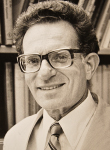Physicist Richard L. Liboff dies at 82
By H. Roger Segelken

Richard L. Liboff, Cornell professor emeritus of electrical and computer engineering, whose classes and books taught physics to thousands around the world – and to one cinematic superhero in particular – died March 9 in New York City. He was 82.
Born Dec. 30, 1931, in Brooklyn, New York, and educated at Brooklyn College (Bachelor of Arts, 1953) and New York University (Ph.D., physics, 1961), Liboff was teaching physics at NYU and working as a research associate at the Courant Institute of Mathematics when Cornell began recruiting.
The School of Electrical Engineering had a new curriculum and research agenda – and hired Liboff, among a crop of promising young faculty, “to meet the demands of modern technology and applied science” in 1964.
At Cornell, Liboff specialized in plasma physics, kinetic theory and electrodynamics, co-chairing the first International Symposium on Kinetic Equations here in 1969. He was the principal investigator on federal grants to study plasma physics, a member of the American Physical Society and of Sigma Xi, the science fraternity. Liboff was promoted to professor of electrical engineering and of applied and engineering physics in 1970.
Clifford Pollock, director of the School of Electrical and Computer Engineering and the Ilda and Charles Lee Professor of Engineering, was “just a rookie assistant professor when I first met [Liboff] in 1983. I was working on lasers, and he was all excited about a patent he had received for a gamma-ray laser. He also liked to ask everyone, ‘Do you play chess?’ I don’t think many people got through Phillips Hall without being asked. Students liked to play tricks on him; he seemed to enjoy them and was a popular professor. He was always upbeat and spent most of his creative energy on committing his scholarship to textbooks.”
The first of five texts was Introduction to the Theory of Kinetic Equations (1969). By 2004, the then-retired Liboff had a certified best-seller with Introductory Quantum Mechanics.
That was the book (fourth edition, 2003) nerdy physics student Peter Parker (aka Spider-Man) dropped when he stumbled while rushing to class at Columbia, 10 minutes into the blockbuster film “Spider-Man 2.”
Fifty million moviegoers had already seen that literary placement when Liboff’s publisher, the San Francisco-based Addison-Wesley, called with the news. Hardly Spider-Man fans, Liboff and his wife, Myra, received comp tickets to the film at a local theater.
He stayed just long enough to see his book dropped – and trampled by a movie extra – then left the theater. Liboff’s 15 minutes of fame lasted “just about one microsecond,” he proclaimed with his customary precision.
Instead Liboff preferred to defend the topic of the text, which by then had sold more than 100,000 copies and was translated into several languages, saying: “Quantum mechanics is the science of very small particles and systems, where classical physics breaks down and you have to use the Schrödinger equation. Most people don’t know who Schrödinger is, but what he did relates to everything you do: automobiles, TV, surgery, radios ... everywhere. That’s quantum mechanics.”
Media Contact
Get Cornell news delivered right to your inbox.
Subscribe